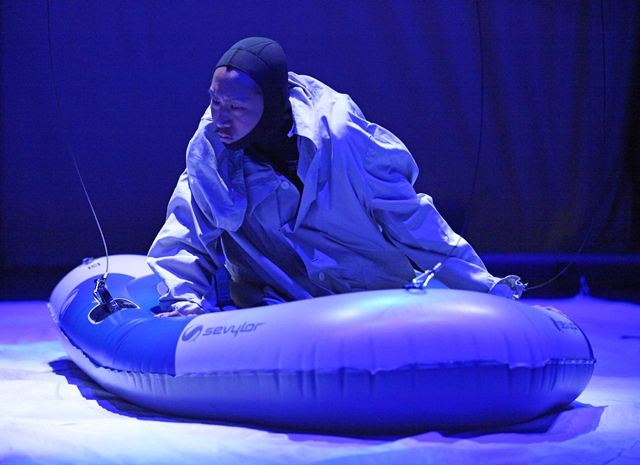“Meditation and water are wedded forever”
—Herman Melville, Moby Dick
For last year’s Live Arts Festival, playwright Thaddeus Phillips took us on a trip to Columbia into the heart of a telenovela soap opera. He returns to the country in this year’s WHaLE OPTICS, but this is just one of myriad settings in a wildly entertaining production more ambitious though less cohesive than his previous offering.

Barrymore-nominated actor James Ijames in WHaLE OPTICS. (Photo credit: Bill Hebert)
Tying the play throughout are an ingenious staging and an entrancing score. The set design (by Phillips) uses simple tools to magical effect. Hanging fixtures function as a library reading room or a underwater garden. A plain tarp becomes a ship, the waves, or a living creature. Artfully created music by Juan Gabriel Turbay soothes transitions and becomes an integral part of the action (though an extended sampled rap at the end of act one was indulgent).
The play, which Phillips created in collaboration with his actors, revolves around two intersecting plotlines. Classical composer Toshi (Makoro Hirano) is commissioned to create a whale-influenced musical piece as part of an ambiguous Whale Optics project headed by professor Reginald Maxwell (James Ijames). After scouring the New York Public Library with the help of reference librarian Hypatia (Emily Letts), Toshi decides to visit the whales in their natural habitat off the coast of Columbia.
As whales journey the oceans, singing songs gradually evolving with new phrases and calls, their age-old communications are being disrupted by interference by fiber-optic cables laid deep beneath the waves. The play’s other plot line follows Roger, a technician (Brian Osborne) manning a lonely fiber-optic station near Avalon, New Jersey. His principal contact with the outside world, excepting phone calls from his mother at home, comes in the from of daily UPS deliveries. When an attractive new delivery girl (Lee Ann Etzold) takes over the route, Roger embarks on a touching effort to woo her using eBay, Groupon, and all the charm picked up from his regular viewing of Carl Sagan documentaries.
Phillips conceived the play after finding a beat-up Sagan paperback marked at the chapter on whales. He was obviously fascinated by the information on their communication, and the way Sagan uses that info to place humans within the larger cosmos. WHaLE OPTICS uses various devices to relay these same ideas to the audience, with varied success. The ideas are fascinating, but are not always easily packaged into natural dialog.
Some characters seem mere devices, but others are fully realized. After a scattered first act, a calming second section sees Toshi in an isolated South American village, with Osborne, Etzold, and Ijames in convincing and rounded second roles. Indeed, for all its inventive set magic, WHaLE OPTICS is driven, too, by strong acting performances. Hirano succeeds as a modern-day Ishmael; others shine in a demanding range of well-created characters.
At an unedited three hours running time, WHaLE OPTICS may benefit from selective cuts, but it never leaves its audience restless. A must-see for this year’s Live Arts, Phillip’s Lucidity Suitcase Intercontinental is also one to watch on future area visits.
WHaLE OPTICS
Directed and designed by Thaddeus Phillips
Created by Makoto Hirano, Brian Osborne, Lee Ann Etzold, James Ijames, and Emily Letts
Original Score by Juan Gabriel Turbay
Sept. 1-11, 2011
Lucidity Suitcase Intercontinental
at the Prince Music Theater
1412 Chestnut Street
Philadelphia, PA
www.livearts-fringe.org

